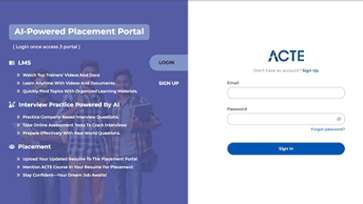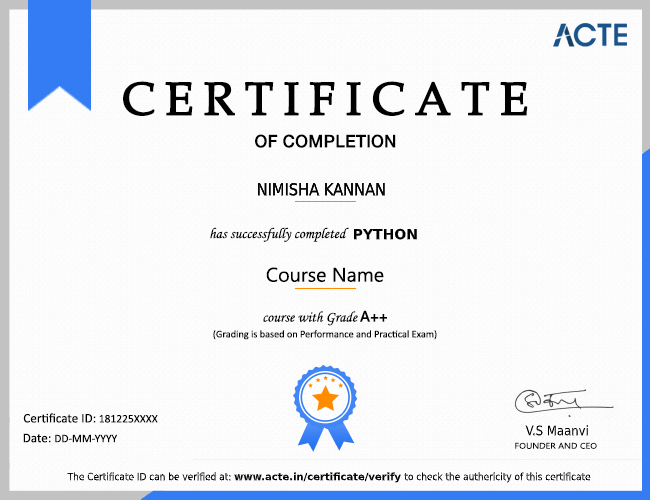Robotic Process Automation (RPA) is a relatively new technology and an ideal technology for many labour-intensive knowledge work. It handles repetitive, and rule-based, large volume tasks particularly well. At ACTE, we will teach everything about RPA step by step and ensure that you excel in your career.Start Learning with us ACTE Robotic Process Automation (RPA) Classroom & Online Training Course.
The growth of the industry and widespread adoption of RPA will drive job growth as well. Many types of jobs are available in RPA, including developer, project manager, business analyst, solution architect, and consultant. This is fact, going to be the future and most important thing in the coming years. RPA in the future is going to incorporate the following things: Incorporating AI for advanced decision-making and inferencing.
Meanwhile, there are so many good opportunities are been involved in the future scope of RPA can be observed in the field of data entry and data rekeying jobs. These tasks could easily automated with RPA. The various repetitive tasks such as formatting, data assembling or anything, which requires a series of steps, that can easily carried out with the help of RPA. RPA will definitely become the next revolution in technology and you will surely find thousands of jobs opening every year. There are more than 5 million jobs awaiting you, right now.
However, robotic process automation (RPA) anticipated evolving and soaring over the forecast period. The modern enterprises need robotic process automation for faster implementation, execution, and scaling. Technological advancements have triggered businesses to overcome new challenges aimed to cope with changing consumer demand and requirements. In the recent past, the adoption of robotic process automation has captured the attention of many SMEs and large enterprises. This can be able to attribute to RPA’s ability to deliver seamless operation coupled with significant value addition from the resources.
We are happy and proud to say that we have strong relationship with over 700+ small, mid-sized and MNCs. Many of these companies have openings in Robotics. Moreover, we have a very active placement cell that provides 100% placement assistance to our students. The cell also contributes by training students in mock interviews and discussions even after the course completion.
Absolutely it’s an future field where, According to Forrester Research (Nov 2015), up to 9% of the global workforce will be threatened by RPA software in the near future. The change is coming, and it is up to process improvement professionals to prepare for this disruption by properly educating their corporations on the do’s and don’ts of RPA. Robotic process automation (RPA) been heralded as the next big thing in process management. Google Trends reports show that the last 2 years have seen a peak in interest in these technologies.
The Difference between Robotic Process Automation and Artificial Intelligence. RPA is a software robot that mimics human actions, whereas AI is the simulation of human intelligence by machines. RPA is a technology that uses specific set of rules and algorithm and based on automated a task. Mean While AI is focused more on doing a human-level task, RPA is practically a software that reduces human efforts — it is about saving the business and white-collar workers' time.
Robotics Process Automation (RPA) allows organizations to automate task just as a human being was doing them across application and systems. ... RPA does not require the development of code, nor does it require direct access to the code or database of the applications. Initially, coding skills are not required. However, if you want to learn more of RPA, at least one programming language would be required to extend the existing RPA functionality. There are no prerequisites for Automation Anywhere. No coding is required..... Automation Anywhere empowers organizations to automate the processes that has been executed by the humans.
Our courseware is designed to give a hands-on approach to the students in Robotics Automation. The course is made up of theoretical classes that teach the basics of each module followed by high-intensity practical sessions reflecting the current challenges and needs of the industry that will demand the students’ time and commitment.
In 2020, RPA is going to claim its place as a central platform for other enterprise automation tools. RPA has been around for the last few years and has advanced considerably. It can manage any types of tasks that are repetitive and predictable. It frees up the resources to focus on tasks that require creativity, decision-making and judgement. As per Forrester, RPA Market will reach $2.9B by 2021.
The future certainly belongs to RPA, and workforces around the world are investing heavily in this efficient technology to fast-track organizational efficiency, effectiveness and profitability. Nonetheless, global robotic process automation has come a long way since 2016. At the time, RPA software purchases amounted to $73 million. This increased to $113 million in 2017, $153 million in 2018, and $192 million in 2019. In 2020, HFS Research estimates that this figure will rise to $232 million and by 2021 to $272 million. These projections indicate that there is strong growth in RPA adoption in the global market. RPA services have increased rapidly since 2016, rising from $198 million, to $630 million in 2019. By 2021, that figure is expected to rise to $952 million. Experts roundly agree that RPA is the future of IT automation
The growth of the industry and widespread adoption of RPA will drive job growth as well. Many types of jobs are available in RPA, including developer, project manager, business analyst, solution architect, and consultant. People are often concerned about robotic process automation taking jobs away from real people. But a lot of companies who need manual data entry already aren’t hiring local employees for those tasks. They’re outsourcing their data entry overseas. Since the bots would be managed/hosted here in the USA, using RPA actually repatriates jobs.
Advantages Of RPA
Decreased costs.
Cost savings of approximately 80-90% can be achieved when a business process performed by an FTE is replaced by a software robot.
Freeing up staff for higher value tasks.
Automation of repetitive and time-consuming processes frees up your staff to make a more value-add contribution. For example, when assessing an insurance claim more time can be spent in the assessment as opposed to populating the same data into 5 various systems.
Increased employee engagement.
When staff can focus on high-value tasks they often feel more invested in the work they are completing. When implementing RPA projects, we often see staff engaging in repetitive activities e.g. copying data between 10 different systems while completing a single customer request, with RPA they can serve an additional 3 clients instead.
Reduced operational risk.
RPA reduces the rate of errors because robots make less mistakes. Avoiding purely human mistakes, such as those made while tired, or by deviating from the process, means a lower level of operational risk.
Reduced output variability.
Robots are great at duplicating tasks consistently with little to no distinguishable variability. It ensures that similar tasks are handled in the same way e.g. underwriting for insurance policies is consistent across the same risk groups.
Reduced paper use/waste.
RPA forces digitization as it requires that companies have the data and files being manipulated by software robots in a digital form. Work that in the past may have been done partly or in full on paper, by an FTE, can now be purely electronic.
Driving process improvement.
In an automation project you often first analyze and then simplify (where possible) the processes to be automated, creating more manageable processes (for both people and machines). For example, if you have 10 different ways to set up a new client in your system, it would make sense to streamline this process first and then automate it.
Increased output.
Automation allows for work to be done 24/7/365 without people fatigue, or quality variance. Often, customers want to interact with service providers outside of a 9-5 timeframe—on evenings and weekends—automation allows you to offer this level of service.
Higher speed and throughput.
Customers receive expedited service as machines are able to process requests in real time. e.g. credit checks, etc.
Improved customer experience.
By deploying RPA you free up expensive and high-value resources, FTEs, from more menial and repetitive tasks and put them back on the front line assisting your customers.
Improved internal service levels.
With RPA things like internal reports can be delivered faster and without mistakes, new employees can be set-up very quickly, and even IT issues can be enormously accelerated.
Defined governance structures.
RPA forces companies to define clear governance structures around IT applications by forcing organizations to agree on who owns each application. Leading to a clearer definition of access rights for each application, since robots, like humans, will need to use the same access.
RPA does not require substituting existing IT systems.
An RPA virtual workforce uses all the same systems your FTEs use. This is one of greatest advantages of RPA in comparison to other automation solutions. In the past, Business Process Management solutions and workflow management tools had to be integrated with each application they interacted with. RPA simply uses the existing systems in the way your FTEs would.
RPA is Scaleable.
Being able to easily scale up or down your operations as needed ensures that companies can make adjustments based on seasonality. In the insurance sector, for example, a virtual workforce can be ramped up in order to process snow/hail claims in the winter, flooding in the summer, etc.
Virtual workforces are highly secure.
Managing IT security for RPA robots is very simple as they do not change roles, leave the company, or retire. They also don’t hack your data.
Increased expertise in core domains.
By automating simple tasks, your company can develop increased expertise in your core domains, such as developing more sophisticated fraud analysis, and/or creating more accurate underwriting algorithms.






























